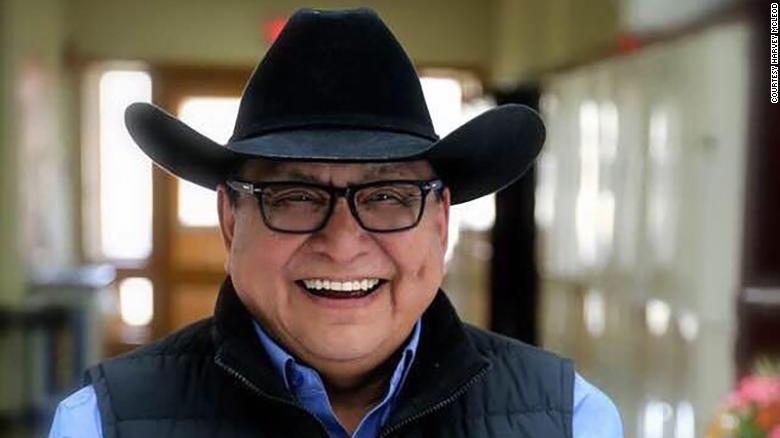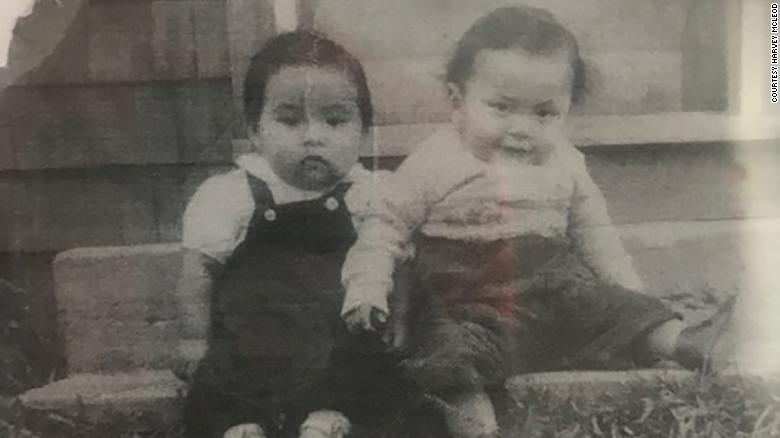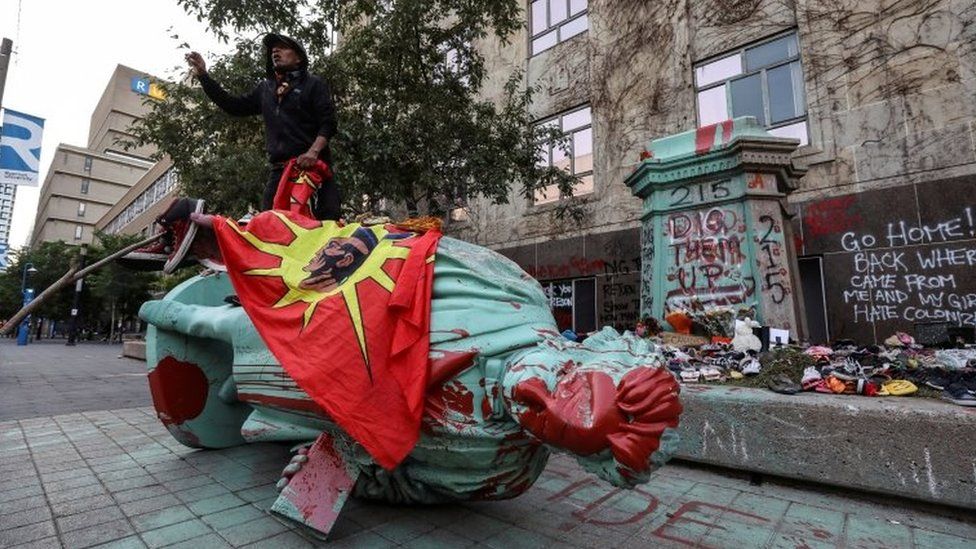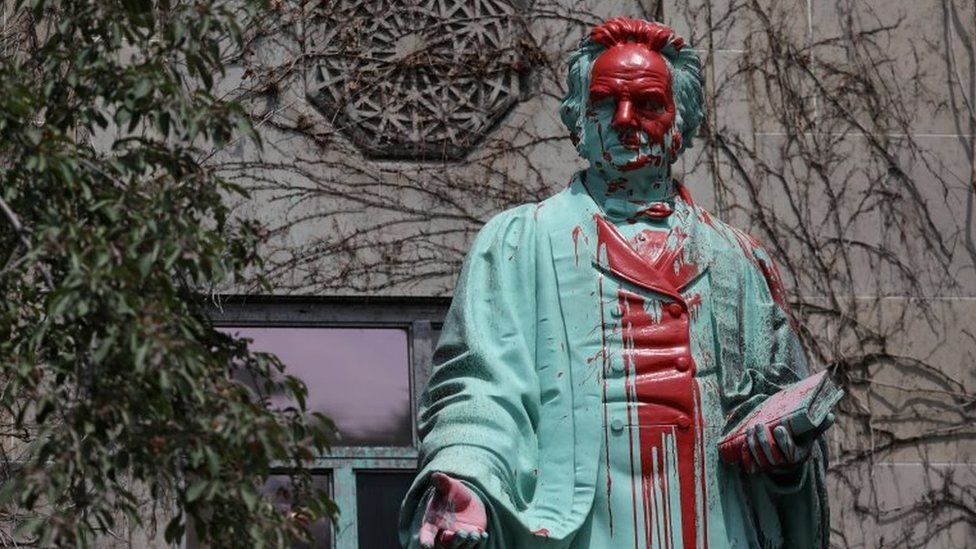Remains of 215 children found at former indigenous school site in Canada
, Source - https://www.reuters.com/world/...e-canada-2021-05-28/
/cloudfront-us-east-2.images.arcpublishing.com/reuters/R3VNYCJ7BJO4NF5RWOWQB6KUKU.jpg) The main administrative building at the Kamloops Indian Residential School is seen in Kamloops, British Columbia, Canada circa 1970. Library and Archives Canada/Handout via REUTERS
The main administrative building at the Kamloops Indian Residential School is seen in Kamloops, British Columbia, Canada circa 1970. Library and Archives Canada/Handout via REUTERS
The remains of 215 children, some as young as three years old, were found at the site of a former residential school for indigenous children, a discovery Canadian Prime Minister Justin Trudeau described as heartbreaking on Friday.
The children were students at the Kamloops Indian Residential School in British Columbia that closed in 1978, according to the Tk'emlúps te Secwépemc Nation, which said the remains were found with the help of a ground penetrating radar specialist.
"We had a knowing in our community that we were able to verify," Tk'emlúps te Secwépemc Chief Rosanne Casimir said in a statement. "At this time, we have more questions than answers."
Canada's residential school system, which forcibly separated indigenous children from their families, constituted "cultural genocide," a six-year investigation into the now-defunct system found in 2015.
The report documented horrific physical abuse, rape, malnutrition and other atrocities suffered by many of the 150,000 children who attended the schools, typically run by Christian churches on behalf of Ottawa from the 1840s to the 1990s.
It found more than 4,100 children died while attending residential school. The deaths of the 215 children buried in the grounds of what was once Canada's largest residential school are believed to not have been included in that figure and appear to have been undocumented until the discovery.
Trudeau wrote in a tweet that the news "breaks my heart - it is a painful reminder of that dark and shameful chapter of our country's history."
In 2008, the Canadian government formally apologized for the system.
The Tk'emlúps te Secwépemc Nation said it was engaging with the coroner and reaching out to the home communities whose children attended the school. They expect to have preliminary findings by mid-June.
In a statement, British Columbia Assembly of First Nations Regional Chief Terry Teegee called finding such grave sites "urgent work" that "refreshes the grief and loss for all First Nations in British Columbia."
/cloudfront-us-east-2.images.arcpublishing.com/reuters/N333G4HYCFMTJG4IFJF5JMPDIA.jpg) A new classroom building at the Kamloops Indian Residential School is seen in Kamloops, British Columbia, Canada circa 1950. Library and Archives Canada/Handout via REUTERS
A new classroom building at the Kamloops Indian Residential School is seen in Kamloops, British Columbia, Canada circa 1950. Library and Archives Canada/Handout via REUTERS

 Historical photo of the Kamloops Indian Residential School, once the largest facility in the Canadian Indian Residential School system. Already known to have been the site of 51 student deaths, recent radar surveys have found evidence of 215 unmarked graves.
Historical photo of the Kamloops Indian Residential School, once the largest facility in the Canadian Indian Residential School system. Already known to have been the site of 51 student deaths, recent radar surveys have found evidence of 215 unmarked graves.






 The Peace Tower flag in Ottawa and flags at all other federal buildings across the country will soon fly at half-mast, following the discovery of 215 victims of residential schools in Kamloops, B.C. (Adrian Wyld/The Canadian Press)
The Peace Tower flag in Ottawa and flags at all other federal buildings across the country will soon fly at half-mast, following the discovery of 215 victims of residential schools in Kamloops, B.C. (Adrian Wyld/The Canadian Press)


/cloudfront-us-east-1.images.arcpublishing.com/tgam/SABE4Y3E4BOHRN7GWR2BJA4CEE.jpg) Kukpi7 (Chief) Rosanne Casimir stands outside the former Kamloops Indian Residential School after speaking to reporters on Friday, June 4, 2021.
Kukpi7 (Chief) Rosanne Casimir stands outside the former Kamloops Indian Residential School after speaking to reporters on Friday, June 4, 2021./https://www.thestar.com/content/dam/thestar/news/gta/2021/06/04/archbishop-of-toronto-offers-explanations-why-catholic-church-hasnt-apologized-for-residential-school-victims/cardinal_collins.jpg)

/cloudfront-us-east-1.images.arcpublishing.com/tgam/W7UD5OBDLVGZLPOULLL2MQOKH4.JPG) Residential school survivor Evelyn Korkmaz at the Mer Bleue bog in Ottawa on Aug. 9, 2019. - Blair Gable/The Globe and Mail
Residential school survivor Evelyn Korkmaz at the Mer Bleue bog in Ottawa on Aug. 9, 2019. - Blair Gable/The Globe and Mail/cloudfront-us-east-1.images.arcpublishing.com/tgam/XLNMQ7NSGNLCJEYIKDJNKUVMHA.jpg) Prime Minister Justin Trudeau visits a memorial at the Eternal flame on Parliament Hill in Ottawa on June 1, 2021, set up in recognition of the discovery of children's remains at the site of a former residential school in Kamloops, B.C. -- Sean Kilpatrick/The Canadian Press
Prime Minister Justin Trudeau visits a memorial at the Eternal flame on Parliament Hill in Ottawa on June 1, 2021, set up in recognition of the discovery of children's remains at the site of a former residential school in Kamloops, B.C. -- Sean Kilpatrick/The Canadian Press/cloudfront-us-east-1.images.arcpublishing.com/tgam/WUVGAMFP55CFPLXW23O636V6SY.jpg) Children praying to a newly arrived French statue of Ste. Therese de l'Enfant Jesus at Holy Angels Boarding School, Fort Chipewyan, Alberta in June, 1931. -- University of Saskatchewan Archives
Children praying to a newly arrived French statue of Ste. Therese de l'Enfant Jesus at Holy Angels Boarding School, Fort Chipewyan, Alberta in June, 1931. -- University of Saskatchewan Archives/cloudfront-us-east-1.images.arcpublishing.com/tgam/NDTJYPUZSFII7FY4445WKLKBN4.jpg) Chief Rosanne Casimir of the Tkemlups te Secwepemc First Nation at the site of the former Kamloops Indian Residential School in Kamloops, B.C. on June 4, 2021. -- COLE BURSTON/AFP/Getty Images
Chief Rosanne Casimir of the Tkemlups te Secwepemc First Nation at the site of the former Kamloops Indian Residential School in Kamloops, B.C. on June 4, 2021. -- COLE BURSTON/AFP/Getty Images/cloudfront-us-east-1.images.arcpublishing.com/tgam/D2Q53CDNL5FGTCKIDFYZDCYTXI.jpg) A Roman Catholic nun washes the hair of a male student at Guy Hill Residential School, 1926. -- Provincial Archives of Saskatchewan
A Roman Catholic nun washes the hair of a male student at Guy Hill Residential School, 1926. -- Provincial Archives of Saskatchewan/cloudfront-us-east-1.images.arcpublishing.com/tgam/5YS3BGASRBJ3PJ6K25KFFPSSAM.jpg) Assembly of First Nations National Chief Perry Bellegarde at a press conference at the National Press Theatre in Ottawa on Feb. 18, 2020. -- Sean Kilpatrick/The Canadian Press
Assembly of First Nations National Chief Perry Bellegarde at a press conference at the National Press Theatre in Ottawa on Feb. 18, 2020. -- Sean Kilpatrick/The Canadian Press/cloudfront-us-east-1.images.arcpublishing.com/tgam/JK6UMCYR4FAYXFU37PMK4UKNKU.jpg) A group of students reading in a classroom at St. Anne's Indian Residential School in Fort Albany, Ont., in 1945. -- Algoma University/Edmund Metatawabin Collection
A group of students reading in a classroom at St. Anne's Indian Residential School in Fort Albany, Ont., in 1945. -- Algoma University/Edmund Metatawabin Collection/cloudfront-us-east-1.images.arcpublishing.com/tgam/ZRZI3BOCEZEQ3KBBFFUSUMX3XM.JPG) Evelyn Korkmaz, who is Cree, was at St. Anne’s for four years, and experienced mental, physical and sexual abuse. -- Blair Gable/The Globe and Mail
Evelyn Korkmaz, who is Cree, was at St. Anne’s for four years, and experienced mental, physical and sexual abuse. -- Blair Gable/The Globe and Mail/cloudfront-us-east-1.images.arcpublishing.com/tgam/3T7K7QQRNJEIPCGF2PEEKI3X5U.JPG) The Kuper Island Indian Residential School on Penelakut Island, B.C., on June 19, 1941. -- HANDOUT/Library and Archives Canada via Reuters
The Kuper Island Indian Residential School on Penelakut Island, B.C., on June 19, 1941. -- HANDOUT/Library and Archives Canada via Reuters


 Ottawa truck driver Roger Steepe organized a truck convoy through the streets of downtown Ottawa Sunday, June 20, 2021, to honour Indigenous peoples and mark the deaths of 215 children whose remains were found at the site of a former residential school in Kamloops, B.C. (Dave Charbonneau / CTV News Ottawa)
Ottawa truck driver Roger Steepe organized a truck convoy through the streets of downtown Ottawa Sunday, June 20, 2021, to honour Indigenous peoples and mark the deaths of 215 children whose remains were found at the site of a former residential school in Kamloops, B.C. (Dave Charbonneau / CTV News Ottawa)/cloudfront-us-east-1.images.arcpublishing.com/tgam/KUYR7KHKSBHJ7OJWBLFWT5PISI.JPG) Assembly of First Nations National Chief Perry Bellegarde on June 18, 2021, in Ottawa. Dave Chan/The Globe and Mail
Assembly of First Nations National Chief Perry Bellegarde on June 18, 2021, in Ottawa. Dave Chan/The Globe and Mail
 Patricia Ballantyne, who started the Walk of Sorrow in Saskatchewan, wears a beaded medallion she was given on her journey to Ottawa. (Holly Caruk/CBC
Patricia Ballantyne, who started the Walk of Sorrow in Saskatchewan, wears a beaded medallion she was given on her journey to Ottawa. (Holly Caruk/CBC Ballantyne started walking by herself near Prince Albert, Sask., but has gained a following since she started out. (Patricia Ballantyne/Facebook)
Ballantyne started walking by herself near Prince Albert, Sask., but has gained a following since she started out. (Patricia Ballantyne/Facebook) The Spirit Sands drumming group sang in memory of children who died in residential schools during the Walk of Sorrows stop at the Peguis First Nation building on Portage Avenue in Winnipeg on Friday. (Holly Caruk/CBC)
The Spirit Sands drumming group sang in memory of children who died in residential schools during the Walk of Sorrows stop at the Peguis First Nation building on Portage Avenue in Winnipeg on Friday. (Holly Caruk/CBC)